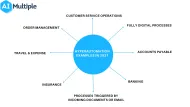Top 4 Trends in Enterprise Hyperautomation in 2024
Hyperautomation is one of the top 12 strategic technology trends of 2022 according to Gartner. It is a business approach that aims to identify and automate all business and IT processes that can be automated. In this article, we’ll explore the top 4 trends in hyperautomation to guide businesses that are embarking on their hyperautomation journey.
1. Intelligent automation that goes beyond routine processes
Robotic process automation (RPA) has been one of the most popular technologies in the shift to digital transformation in the enterprise. However, hyperautomation requires automation tools to have cognitive abilities for end-to-end process automation. That is why intelligent automation is one of the core technologies within hyperautomation efforts. It is the combined use of RPA with artificial intelligence (AI) technologies such as:
- Machine learning
- Natural language processing (NLP)
- Intelligent document processing (IDP)
- Optical character recognition (OCR)
- Conversational AI
and more. AI-powered automation can execute rule-based as well as more complex processes end-to-end and work with both structured and unstructured data. This helps improve process efficiency and free up employee time for more value-added tasks.
Most of the major RPA vendors provide either built-in cognitive capabilities or marketplaces to add customized cognitive capabilities for intelligent automation. Feel free to check our article on RPA marketplaces for more.
2. Process mining is one of the core hyperautomation technologies
Automating business and IT processes is at the core of hyperautomation, so it is important for businesses to have visibility over the processes to be able to determine which processes to automate and how to automate them. Process mining enables businesses to:
- Understand the as-is state of their existing processes,
- Identify process improvement opportunities,
- Prepare processes to get the most from automating them.
It is reported that by using process mining during RPA implementation, businesses can increase the business value by 40% while reducing RPA implementation time by 50% and RPA project risk by 60%.
The synergy between process mining and automation is evident and major intelligent automation vendors have either integrated process mining capabilities in their solutions or partnered with process mining vendors for integration.
3. Digital twins will go hand in hand with hyperautomation
As hyperautomation involves a holistic approach to automation in an organization, it can benefit from creating a digital twin of an organization (DTO). A DTO is a virtual representation of an entire organization including products, services, processes, employees, and other assets. The market for digital twins is expected to be $36 billion by 2025 and the enterprise hyperautomation efforts can be one of the driving forces of digital twin adoption in business.
A DTO helps:
- Analyze individual processes and the interactions between them,
- Identify inefficiencies of products, services, or processes,
- Run simulations and conduct predictions about the outcomes of changes in processes, products, or services.
Digital twins provide real-time visibility and intelligence over entire processes and assets of businesses. This can help businesses develop strategies for their hyperautomation initiatives and analyze how to:
- Improve processes before automation,
- Automate them,
- Manage the relationship and integration between different automated processes.
Another emerging trend for digital twins is the integration between process mining and DTOs. Some process mining vendors offer DTO capabilities to help businesses facilitate their automation journey and de-risk process modifications.
Read our complete guide on process mining and digital twins for more.
4. Low-code and no-code tools enable everyone to automate
Since hyperautomation requires rapid identification and automation of as many processes as possible, the democratization of AI/ML development and bot creation becomes a crucial part of it.
Low-code and no-code AI and RPA tools enable non-technical personnel, called citizen developers, to create AI and automation applications with a visual and drag-and-drop interface. According to Gartner, 70% of new applications developed will use low-code or no-code technologies by 2025. Low and no-code development provides benefits such as:
- Easier involvement for domain experts that know the details of business processes,
- Reduced time for developing and programming automation applications,
- Reduced necessity to invest in hiring or training technical staff,
- Simplified management and maintenance of automation bots.
Feel free to check our articles on no-code RPA, no-code AI, and low/no-code software development for more.
If you have other questions about hyperautomation and its trends, we can help:

Cem has been the principal analyst at AIMultiple since 2017. AIMultiple informs hundreds of thousands of businesses (as per similarWeb) including 60% of Fortune 500 every month.
Cem's work has been cited by leading global publications including Business Insider, Forbes, Washington Post, global firms like Deloitte, HPE, NGOs like World Economic Forum and supranational organizations like European Commission. You can see more reputable companies and media that referenced AIMultiple.
Throughout his career, Cem served as a tech consultant, tech buyer and tech entrepreneur. He advised businesses on their enterprise software, automation, cloud, AI / ML and other technology related decisions at McKinsey & Company and Altman Solon for more than a decade. He also published a McKinsey report on digitalization.
He led technology strategy and procurement of a telco while reporting to the CEO. He has also led commercial growth of deep tech company Hypatos that reached a 7 digit annual recurring revenue and a 9 digit valuation from 0 within 2 years. Cem's work in Hypatos was covered by leading technology publications like TechCrunch and Business Insider.
Cem regularly speaks at international technology conferences. He graduated from Bogazici University as a computer engineer and holds an MBA from Columbia Business School.
To stay up-to-date on B2B tech & accelerate your enterprise:
Follow on
Comments
Your email address will not be published. All fields are required.